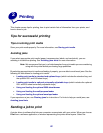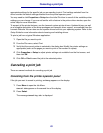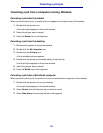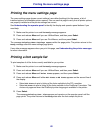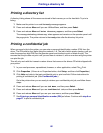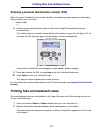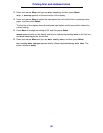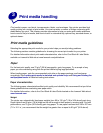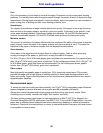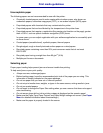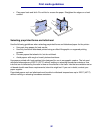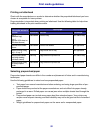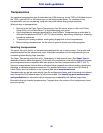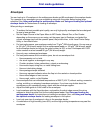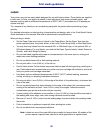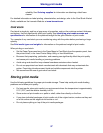
30
Print media guidelines
Curl
Curl is the tendency of print media to curve at its edges. Excessive curl can cause paper feeding
problems. Curl usually occurs after the paper passes through the printer, where it is exposed to high
temperatures. Storing paper unwrapped in humid conditions, even in the paper tray, can contribute to
paper curling prior to printing and can cause feeding problems, also.
Smoothness
The degree of smoothness of paper directly affects print quality. If the paper is too rough, the toner
does not fuse to the paper properly, resulting in poor print quality. If the paper is too smooth, it can
cause paper feeding problems. Smoothness needs to be between 100 and 300 Sheffield points;
however, smoothness between 150 and 250 Sheffield points produces the best print quality.
Moisture content
The amount of moisture in the paper affects both print quality and the ability of the printer to feed the
paper properly. Leave the paper in its original wrapper until you are ready to use it. This limits the
exposure of the paper to moisture changes that can degrade its performance.
Grain direction
Grain refers to the alignment of the paper fibers in a sheet of paper. Grain is either grain long,
running the length of the paper, or grain short, running the width of the paper.
For 60 to 135 g/m
2
(16 to 36 lb bond) paper, grain long fibers are recommended. For papers heavier
than 135 g/m
2
(36 lb bond), grain short is preferred. For the multipurpose feeder, 60 to 135 g/m
2
(16
to 36 lb bond) paper, grain long fibers are recommended. For the multipurpose feeder, papers
heavier than 135 g/m
2
(36 lb bond), grain short is preferred.
Fiber content
Most high-quality xerographic paper is made from 100% chemically pulped wood. This content
provides the paper with a high degree of stability resulting in fewer paper feeding problems and
better print quality. Paper containing fibers such as cotton possess characteristics that can result in
degraded paper handling.
Recommended paper
To ensure the best print quality and feed reliability, use 75 g/m
2
(20 lb) xerographic paper. Business
papers designed for general business use may also provide acceptable print quality.
Always print several samples before buying large quantities of any type of print media. When
choosing any print media, consider the weight, fiber content, and color.
The laser printing process heats paper to high temperatures of 225°C (437°F) for Magnetic Ink
Character Recognition (MICR) applications, and 205°C (401°F) for non-MICR applications. Use only
paper able to withstand these temperatures without discoloring, bleeding, or releasing hazardous
emissions. Check with the manufacturer or vendor to determine whether the paper you have chosen
is acceptable for laser printers.



